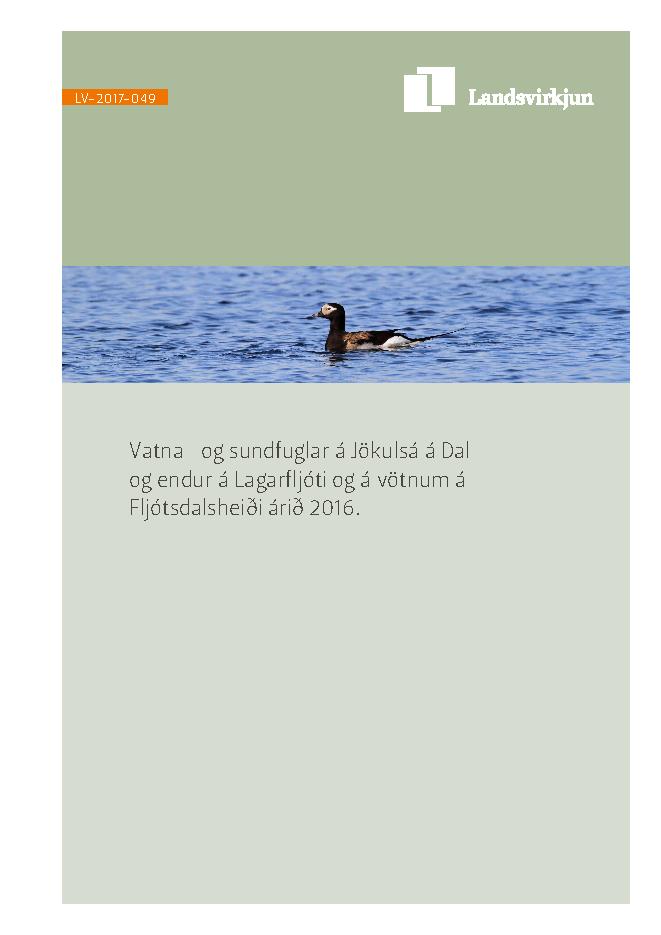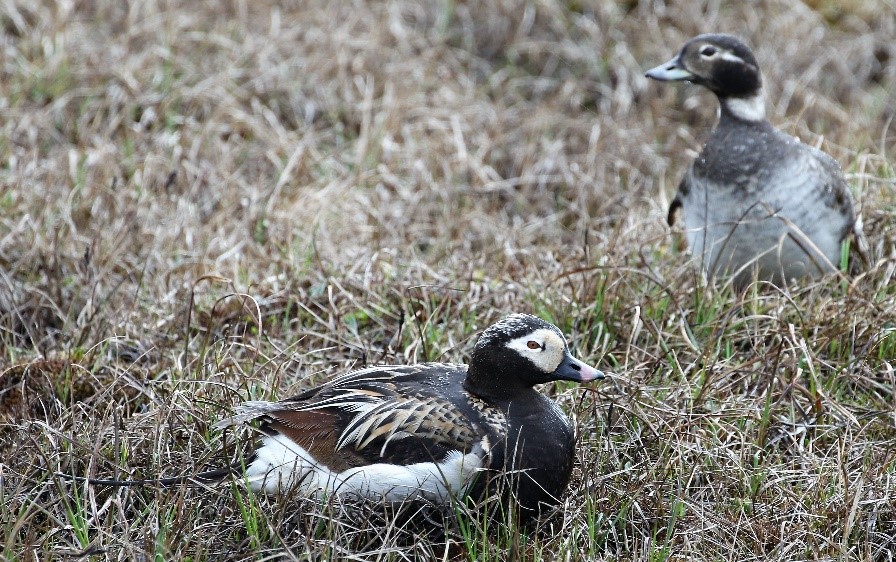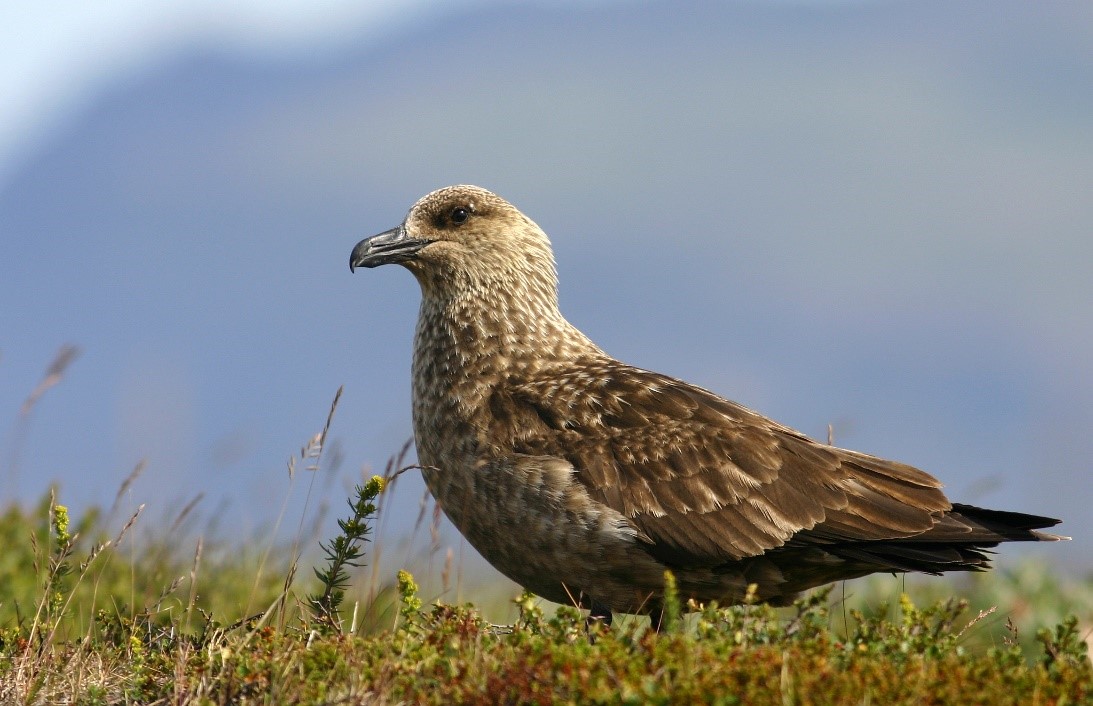Progress
Since the initial monitoring plan, several changes have been made based on research results and a revised definition of baseline conditions. Here is a recount of the progress of the three indicators.
Distribution of long-tailed duck (hávella) on Lagarfljót River during summer.
Figure 1. Long-tailed ducks on Lagafljót River 2005-2023. Six countings were carried out each summer, but from 2017, there were three countings each summer and twice since 2021.
The number of long-tailed ducks on the Lagarfljót River has fluctuated since counting began in connection to the building of the Kárahnjúkar powerplant in 2005. The number decreased significantly during the first years of the powerplant operation from 2008 to 2012 (Figure 1). A possible explanation for this decrease was considered to be increased turbidity in the river in conjunction with the transfer of Jökulsá á Dal to Lagafljót with the introduction of Háslón, but increased turbidity can reduce the diver's food conditions. However, this does not have to be the case, as a decrease could be seen as early as 2007, compared to the summer of 2006, but water transport did not begin until after the summer of 2007. Another possible explanation for fewer long-tailed ducks on Lagarfljót during this period was related to stock fluctuations. However, little is known about the state of the stock in Iceland or whether the distribution has changed.
In 2021, a report was published outlining the research results on birds in the impact area of the Kárahnjúkar Power Plant in the period 2004-2020. The report stated that the largest groups of long-tailed ducks during the research period 2005-2020 on Lagarfljót were counted in 2006 (363 birds) and 2007 (215 birds). After that, the largest group decreased significantly, and the number was quite volatile. On average, 56 birds were seen yearly from 2008 to 2020, the fewest 21 birds in 2015 and 72 birds in 2013.
Comparisons with older data from the years 1990 to 2000 showed that the most significant groups counted in 2006 and before water transport began in 2007 were unusually large, and there were no significantly fewer long-tailed ducks in the most significant groups after water transport, from 2008-2020, compared with counts from 1990 to 2007.
From 2021, the number of counts on Lagarfljót was reduced by only counting twice during the summer. The highest total number of long-tailed ducks on Lagarfljót in the first two counts of the summer since 2007 was in 2020. Since then, the total number of long-tailed ducks in two counts has decreased yearly until 2023.
Figure 2. Long-tailed ducks. Photograph Skarphéðinn G. Þórisson
Further analysis of data from 2005 to 2023, it became apparent that the so-called nesting units (individual nesting birds of both sexes during the breeding season in preferred nesting grounds, pairs with young, nests, and orphaned young) increased at Lagarfljót (figure 3) while the total number decreased at the same time, with the exception few years (figure 1). Therefore, it can be assumed that Lagarfljót is a vital stopover/destination for nesting bird species despite the water transfers 2007. Since 2018, nesting units elsewhere in the Héraðs area but at Lagarfljót have decreased, and in 2023, the number was the lowest measured since 2005 (figure 3). Transfers within the area could explain these changes.
Figure 3. The number of defined breeding units on the Lagarfljót River and the surrounding area Hérað, respectively, from 2005 to 2023.
The three species of ducks that were studied decreased in numbers on Lagafljót in 2009 - 2012 compared to previous years, but they have been regaining strength in recent years. However, variability between years has been significant. Thus, 2019, for example, was particularly dismal for these species. That year's weather might have had some impact, as the summer in the east was relatively cool and moist. Then, the highest number of mallards since records began was observed at Lagarfljót in 2022, having previously peaked in 2005. In 2023, there was a decrease in the largest groups of mallards and long-tailed ducks, but the number of tufted ducks increased from the previous year (figure 4).
Figure 4. Largest groups of long-tailed ducks, tufted ducks in the spring, and mallards in the winter on Lagarfljóti in 2005-2023.
Updated: March 26, 2024
Source: Landsvirkjun 2017, East Iceland Nature Research Center 2024
Graylag goose
The graylag goose population was studied in 2005 and again in 2013. The results suggested that water transport had a limited impact on the graylag goose population. Therefore, there were no grounds to monitor it further concerning the power plant.
The number of nesting great skuas (skúmur) in Jökulsá á Dal river outwash plain.
Figure 4. Great skua. Photograph Halldór Walter Stefánsson
In 2021, a report was published detailing the results of studies on birds in the area of influence of the Kárahnjúka power plant from 2004-2020, including skua. The number of skuas fluctuated considerably in 2005-2021, even since 2000, without any apparent connections to the activities of Kárahnjúkavirkjun. The fluctuations are probably related to external factors and changes in the population. Still, since 2015, there has been a gradual increase, and the number has become similar to what it was in the area before the power plant (Figure 5). The number of breeding units decreased from 2008-2011, and their number has remained almost unchanged since then.
Figure 5. The numbers of great skua in the riverbed of Jökulsá á Dal River when the environmental impact assessment was carried out in 2000 (Guðmundur A. Guðmundsson et al. 2001) and results from the monitoring in 2005 - 2009, 2011 and 2013-2016 (Halldór W. Stefánsson 2016) as well as counting the summer of 2017 til 2023. The same areas are monitored each year similarly, and no countings were carried out from 2001-2004 and 2010 and 2012.
Updated: March 27, 2024
Source: Landsvirkjun, 2024 and East Iceland Nature Research Center, 2021
Metrics, Targets and Monitoring Protocol
What is measured?
- Long-tailed duck (hávella), tufted duck (skúfönd) and mallard (stokkönd) – distribution and count at Lagarfljót river during summer. (Project effect: indirect).
- Number of molting and nesting graylag goose (grágæs) in Jökulsá á Dal river outwash and geese without goslings by Lagarfljót river. (Project effect: indirect).
- Number of nesting great skuas (skúmur) in Jökulsá á Dal river outwash and parts of Úthérað area close to Héraðsflói bay (Project effect: indirect).
Monitoring protocol
- Long-tailed duck: Baseline information was gathered 2005-2007. Monitored each year since then.
- Graylag goose: Baseline information was gathered in 2005. Study repeated every 5-10 years.
- Great skua: Baseline information was gathered 2005-2007 and repeated in 2008, 2009, 2011 and 2013. Monitored each year in parts of the area to begin with, and every 5-10 years in the whole Úthérað area.
Targets
Expectations rather than targets apply for this indicator
- Distribution of long-tailed duck will not change.
- Number of molting graylag goose in Jökulsá á Dal river outwash remains unchanged.
- Number of great skua nests in Jökulsá á Dal river outwash remains unchanged.
Possible countermeasures
None - monitoring only
Updated: December 7, 2015
Changes of indicator
At the annual meeting of the initiative in 2018 the following proposed amendments were passed
| Original text | Amended text |
|---|---|
|
What is measured?
|
What is measured? Observation of red-throated diver (lóms) discontinued.
|
Rationale for amendments
The monitoring protocol has undergone some changes since the project started. All changes are made by consulting bird experts. Baseline studies in 2004 – 2005 revealed that red-throated divers did not fetch food inland nor at the Lagarfljót river and, therefore, no reason to monitor them.
The population of long-tailed duck was not considered the appropriate term. Therefore, the monitoring was redefined to monitor the distribution of long-tailed duck at the Lagarfljót river during summer. In addition, research of other species of the Anatidae family was added.
In the beginning, the number of molting graylag geese in the Jökulsá á Dal river outwash was monitored. It was changed to the number of graylag geese with goslings and molting geese in the Jökulsá á Dal outwash and geese without goslings by the Lagarfljót river. This is expected to give a better picture.
At first, the number of great skua nests was counted, but now the number of great skuas is monitored and considered a more realistic measure.
All these changes are made to capture nature's variability and essential for the initiative to be flexible enough to adjust to natural fluctuations.
The original monitoring protocol was written as follows:
- Experts from the Icelandic Institute of Natural History (IINH) will collect data. Flying directions of the red-throated divers will be mapped and their behaviour monitored at key locations to find out how much they depend on the rivers and the sea respectively as food sources. Baseline studies to take place in the summers of 2004 and 2005.
- Experts from the IINH will collect data. Birds will be counted and distribution mapped. Baseline studies to be collected in 2005 and new data collected in 2015.
- Experts from the IINH will collect information. Bird count based on both aerial photos and field studies. Baseline studies to be collected in 2005 and new information collected in 2015.
- Experts from the IINH will collect information. The birds will be counted every year in the period 2005-2008.
This indicator was originally number 24.3. It was then named Breeding birds at Úthérað and can be found under that number in documents of the project from 2005 and 2006.
The indicator number has been changed twice.
| Year | Nr. | Indicator name |
|---|---|---|
| 2020 | 2.5.3 | Breeding birds at Úthérað |
| 2007 | 2.22 | Breeding birds at Úthérað |
Baseline
It was thought that the establishment of the Kárahnjúkar power plant would possibly affect the food supply of red-throated divers in the area. The behavior of the red-throated divers was studied in 2004 and 2005. The results indicated that the birds mainly seek food in the ocean, and therefore there was no reason to monitor it any further.
Deductions about the power plant’s impact on long-tailed duck are based on comparison to monitoring done in 2005 during its run-up. However, employees at East Iceland Nature Research Centre have monitored common duck species on Lagarfljót river for a much longer time, or since 1989. The maximum number of long-tailed duck on Lagarfljót river reported in older sources was 440 birds on June the 9th 1983. The large numbers in Lagarfljót in early summer of 1983 were believed to be related to harsh conditions at the highland lakes in East Iceland (Skarphéðinn Þórisson, 1990). Older studies thus indicate peak numbers of long-tailed ducks during different periods. The same source states that the long-tailed duck was the most common migrating duck on the Lagarfljót river and that the average size of flocks during countings from May to June was 107 birds (through 16 counts). All species of ducks on the Lagafljót river declined in numbers from 2009 to 2012 compared to previous years, but have been recovering in recent years, except for the mallard. Annual variability is significant. From 2016 to 2019, the numbers of tufted duck (skúfönd), mallard (stokkönd) and long-tailed ducks (hávella) seem to be declining. The year 2019 seems particularly bad for these species. The summer in East Iceland that year was rather cold and humid and that could explain the low numbers (Figure 6).
Figure 6. Variations in the size of the largest flocks (fjöldi) of long-tailed duck (hávella) and tufted duck (skúfönd) during spring and mallard (stokkönd) during winter on the Lagarfljót river.
Great skuas were counted in Úthérað from the year 2006 to 2013, except for the years 2010 and 2012. Initially, it was assumed that there would be support from similar research elsewhere in Iceland, such as from Öxarfjörður and Breiðamerkursandur. No comparable counts are known from Breiðamerkursandur during these years, but some observations are available from Öxarfjörður. A comparison with counts in Öxarfjörður showed that there was also variation in the number there between years, as in Úthérað (Figure 7).
Figure 7. Comparison of the numbers of great skuas in Úthérað and in Öxarfjörður in 1984, 2007 and 2009 (numbers from Öxarfjörður from Þorkell Lindberg Þórarinsson o.fl. 2013).
Revised and updated: March 17, 2021
Source: Landsvirkjun 2017, East Iceland Nature Research Center 2021.
-
Skarphéðinn Þórisson 1990. Fuglalíf við Egilsstaðaflugvöll. Bliki 9: 29-40
- Þorkell Lindberg Þórarinsson, Aðalsteinn Örn Snæþórsson, Böðvar Þórisson, Guðmundur A. Guðmundsson, Halldór Walter Stefánsson, Kristinn Haukur Skarphéðinsson og Yann Kolbeinsson 2013. Fuglar á Austursandi við Öxarfjörð. Bliki 32: 59–66.
Waterfowl and swimming birds on Jökulsá á Dal
In the summer of 2014 the East Iceland Nature Center started monitoring the emerging of waterfowl on the river Jökulsá á Dal due to changes in its ecosystem related to water transport with the introduction of the Kárahnjúkar hydropower plant. The most common birds are gulls, ducks, whooper swans, and red-throated divers. The observations are carried out for three days each summer in the Jökulsá á Dal river, often called Jökla for short.
Figure 8. The numbers of the most common birds seen on the river Jökulsá á Dal from 2014-2020
Whooper swans have increased noticeable since the monitoring started in 2014, while the numbers of ducks seem relatively stable. More fluctuations were detected in the numbers of gulls of various species (Figure 8). From 2014 to 2020, the number of ducks has decreased, the numbers of red-throated divers have remained stable, the numbers of gulls, arctic skuas, and arctic terns have fluctuated somewhat, and the numbers of whooper swans have increased (Figure 9).
Figure 9. Gulls, arctic skua, arctic tern, cormorant, red-throated dive and fulmar in Jökla river 2014 – 2019.
Lesser black-backed gull (sílamáfur) has been the most common gull at Jökla, but the lowest numbers were recorded in the summer of 2019. A small increase was detected in 2020. Other waterfowl and swimming birds that are prominent include arctic tern, red-throated diver, and arctic skua. Common gull, great cormorant, and fulmar are less common (Figure 9). One bird of the species glaucous gull (stormmáfur) was first seen in Jökla in 2018.
Figure 10. Anatidae by Jökulsá á Dal 2014-2020.
The numbers of whooper swans in Jökla river are noticeable higher than other species in the Anatidae family, excluding the two goose species; greylag goose and pink-footed goose, not discussed here. The numbers of the eight duck species seen in Jökla have been relatively constant between years from 2014(Figure 10). Still, the observation period is too short to draw firm conclusions. Most of these ducks were only known on the tributaries of Jökla before the water transport in 2007. Dabbling ducks have been more common than diving ducks in the Jökla river, which probably can be explained by the supply of food in the river. It can be expected that the numbers of divers will increase in the future. The most common duck on Jökla is in fact, the diving duck, harlequin, which has been used as a measure of food such as caddis fly and black fly larvae.
Arctic skua has been monitored along with waterfowl in the river Jökulsá á Dal. The observation area is from Skjöldólfsstaðir farm to Húsey farm. The numbers have fluctuated, with the largest numbers detected in 2016 and the fewest birds seen in 2014. In 2020 the numbers of arctic skuas declined compared to the previous summer (Figure 11).
Figure 11. The number of arctic skua in the riverbed of Jökla river from 2014 to 2020.
Arctic skua has also been monitored from 2005 to 2020 on a road section in Hróarstunga in Úthérað between the farms of Húsey and Geirastaðir. The numbers of birds detected decreased each year during the first three years, from 40 birds to 22 birds. Since then, the numbers have fluctuated between six and fifteen birds (Figure 12).
Figure 12. The numbers of arctic skua in the area between Húsey and Geirastaðir farms 2005 - 2020.
Revised and updated: March 17, 2021
Source: Landsvirkjun og East Iceland Nature Research Center 2021.
Rationale for Indicator Selection
Estimating the impact of the Kárahnjúkar dam on birdlife at Úthérað area is difficult since it is affected as much or more by many other factors. Research indicates that hydrologic changes will probably have an insignificant impact on vegetation. Therefore, this indicator focuses on bird species expected to be either dependent on Lagarfljót river for food or affected by changes in the Jökulsá á Dal river riverbed. For example, it was considered possible that better access to Jökulsá á Dal outwash could lead to fewer graylag geese in molting areas at the outwash. It was also considered possible that easier access for predators could have a negative impact on the breeding of the great skua.
From phase I/II report on indicators and baseline from April 2005
Further reading

LV-2017/049 - Vatna- og sundfuglar á Jökulsá á Dal og endur á Lagarfljóti og á vötnum á Fljótsdalsheiði árið 2016.
You can view more material related to the indicator by clicking the link above.
Further analysis of data from 2005-2021 revealed that defined breeding units (pairs with nestlings, nests, or orphaned nestlings) increased in the Lagarfljót river and elsewhere in the Hérað area (Figure 3). At the same time, there was a decrease in long-tailed ducks on Lagarfljót between 2006 and 2013, with a noticeable increase in 2013 and 2014, then again in 2020 and 2021 (Figure 1). Therefore, it can be assumed that Lagarfljót is still a significant stop/destination for the species' breeding birds, despite the water transport in 2007. From 2017 to 2021, the number of breeding units has decreased elsewhere in the Hérað area but not in Lagarfljót. From 2016, on the other hand, the number of breeding units on Lagarfljót has increased until 2021, and there may be some shifts within the area of influence of the Kárahnjúkar power plant that could indicate these changes.


